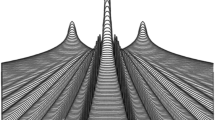Abstract
In this manuscript a short review on the most popular numerical techniques in Quantum mechanics used to determine properties of the resonant states is presented. Some common ambiguities arising when theoretical calculations are compared with the experimental data are also highlighted.









Similar content being viewed by others
References
M.T. Pena, A.C. Fonseca, Use of splines to calculate resonance poles and Gamow states. Phys. Rev. C 36(5), 1737 (1987)
Y.K. Ho, The method of complex coordinate rotation and its applications to atomic collision processes. Phys. Rep. 99(1), 1 (1983)
N. Moiseyev, Quantum theory of resonances: calculating energies, widths and cross-sections by complex scaling. Phys. Rep. 302(5–6), 212–293 (1998)
R. Lazauskas, arXiv:1904.04675 (2019)
R. Hartree, J.G.L. Michel, N.P., Meteorological factors in radiowave propagation, Report of a Conference held on 8th April 1946 at The Royal Institution, London by The Physical Society and The Royal Meteorological Society (The Physical Society, London), pp. 127–168 (1946)
J.N.L. Connor, Scattering amplitude without an explicit enforcement of boundary conditions. J. Chem. Phys. 78, 6161 (1983)
J. Nuttal, H.L. Cohen, Method of complex coordinates for three-body calculations above the breakup threshold. Phys. Rev. 188, 1542–1544 (1969)
F.A. McDonald, J. Nuttall, Neutron-deuteron elastic scattering above the breakup threshold. Phys. Rev. C 6, 121–125 (1972)
J. Aguilar, J.M. Combes, A class of analytic perturbations for one-body Schrödinger Hamiltonians. Commun. Math. Phys. 22, 269 (1971)
E. Balslev, J.M. Combes, Spectral properties of many-body Schrödinger operators with dilatation-analytic interactions. Commun. Math. Phys. 22, 280 (1971)
T.N. Rescigno, M. Baertschy, W.A. Isaacs, C.W. McCurdy, Collisional breakup in a quantum system of three charged particles. Science 286(5449), 2474–2479 (1999)
B. Simon, The definition of molecular resonance curves by the method of exterior complex scaling. Phys. Lett. A 71(2), 211–214 (1979)
J. R. Taylor, Scattering Theory: The Quantum Theory of Nonrelativistic Collisions, Courier Corporation (2006)
A. Deltuva, Three-neutron resonance study using transition operators. Phys. Rev. C 97(3), 034001 (2018)
A. Deltuva, Tetraneutron: Rigorous continuum calculation. Phys. Lett. B 782, 238–241 (2018)
V. Kukulin, V. Krasnopolsky, Description of few body systems via analytical continuation in coupling constant. J. Phys. A 10, L33–L37 (1977)
V. Krasnopolsky, V. Kukulin, Theory of resonance states based on analytical continuation in the coupling constant. Phys. Lett. A 69(4), 251–254 (1978)
V.I. Kukulin, V.M. Krasnopolsky, J. Horácek, Theory of Resonances: Principles and Applications (Reidel Texts in the Mathematical Sciences, Springer, Netherlands, 1989)
Jr, G. A. Baker, The theory and application of the Padé approximant method,Los Alamos Scientific Lab., Univ. of California, N. Mex. (1964)
A. Hemmdan, W. Gløckle, H. Kamada, Indications for the nonexistence of three-neutron resonances near the physical region. Phys. Rev. C 66, 054001 (2002)
R. Lazauskas, J. Carbonell, Three-neutron resonance trajectories for realistic interaction models. Phys. Rev. C 71, 044004 (2005)
R. Lazauskas, J. Carbonell, Is a physically observable tetraneutron resonance compatible with realistic nuclear interactions? Phys. Rev. C 72, 034003 (2005)
R. Lazauskas, E. Hiyama, J. Carbonell, Ab initio calculations of 5H resonant states. Phys. Lett. B 791, 335 (2019)
H.S. Taylor, Models, interpretations, and calculations concerning resonant electron scattering process in atoms and molecules. Adv. Chern. Phys. 18, 91 (1970)
J. Simons, Resonance state lifetimes from stabilization graphs. J. Chem. Phys. 75(5), 2465–2467 (1981)
Q. Meng, M. Harada, E. Hiyama, A. Hosaka, M. Oka, Doubly heavy tetraquark resonant states. Phys. Lett. B 824, 136800 (2022)
E. Hiyama, R. Lazauskas, J. Carbonell, 7H ground state as a 3H+ 4n resonance. Phys. Lett. B 833, 137367 (2022)
Acknowledgements
In preparing this manuscript I have benefited from the grant of French CNRS/IN2P3 for a theory project “Neutron-rich light unstable nuclei”. I was also granted access to the HPC resources of TGCC/IDRIS under the allocation A0110506006 made by GENCI (Grand Equipement National de Calcul Intensif). Part of this manuscript has been prepared during the program Living Near Unitarity at the Kavli Institute for Theoretical Physics (KITP), University of Santa Barbara (California) is supported in part by the National Science Foundation under Grant No. NSF PHY-1748958.
Author information
Authors and Affiliations
Corresponding author
Additional information
Publisher's Note
Springer Nature remains neutral with regard to jurisdictional claims in published maps and institutional affiliations.
Rights and permissions
Springer Nature or its licensor (e.g. a society or other partner) holds exclusive rights to this article under a publishing agreement with the author(s) or other rightsholder(s); author self-archiving of the accepted manuscript version of this article is solely governed by the terms of such publishing agreement and applicable law.
About this article
Cite this article
Lazauskas, R. Numerical Aspects of Resonant States in Quantum Mechanics. Few-Body Syst 64, 24 (2023). https://doi.org/10.1007/s00601-023-01808-x
Received:
Accepted:
Published:
DOI: https://doi.org/10.1007/s00601-023-01808-x




